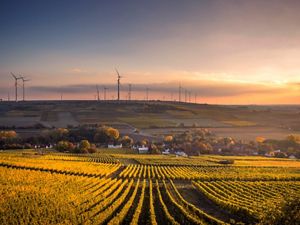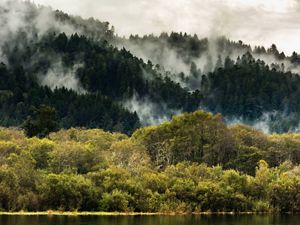The Climate Challenge Unites Us
These days it’s easy to be pessimistic on climate change, but there is cause for hope.
At The Nature Conservancy we don’t shy away from big challenges. For 67 years, we’ve tackled complex threats, such as habitat loss and fragmentation, altered fire regimes, invasive species and overfishing. Today, the biggest challenge we face is climate change. And as you will see in this issue of the magazine, we are doing everything we can to address this challenge in the most impactful way.
The consequences of a changing climate are dangerous and costly. We can already see the impacts, including chronic droughts, rising seas, higher temperatures and more frequent and extreme storms. The string of hurricanes and wildfires across the U.S. in 2017, for example, cost $306 billion in damages—a record-breaking number according to the National Oceanic and Atmospheric Administration. These climate threats undermine the economic security of the world’s most vulnerable people. And they are already threatening some species and causing others to relocate.
Recently, we lost an important partner in addressing the climate challenge: the U.S. federal government. Despite this, I remain optimistic about two things: the leadership role of U.S. state and local governments—both red and blue—and the role that the private sector is playing around the world.
In this issue we highlight some of the actions, policies and partnerships TNC has led to address climate change and the threat it poses to our mission.
Across 50 States / The Conservancy is a global organization, but we have our deepest roots in the United States. The political outlook on climate in the U.S. is not as polarized as headlines make it seem. Across all 50 states, important bipartisan actions are arising and coalitions are coming together to raise awareness, reduce greenhouse-gas emissions and transition to a low-carbon future.
We are doing our best to make all of this happen at the state level, drawing on TNC’s robust operations in all 50 states. Our volunteer leaders are pushing state and local governments, building alliances with business leaders and engaging with community-based organizations. As always, we are finding common ground by bringing people together, building on years of trusted partnerships and advocating for pragmatic, science-based solutions. We are strengthened in this endeavor by great partners, including the Environmental Defense Fund, the MacArthur Foundation and the Center for the New Energy Economy, to name just a few
We can be very proud of our state chapters as they step up in new ways to demonstrate leadership and build momentum for climate action. A first-in-class example is the California chapter’s active role in organizing the Global Climate Action Summit this fall. This forum, convened by Gov. Jerry Brown and others, will give us the opportunity to share our strategies for climate protection and adaptation. Our participation here builds on years of work by the California chapter in supporting and shaping the state’s cap-and-trade program to reduce carbon emissions.
Or consider TNC’s work in West Virginia, where the state faces the challenge of transitioning away from a coal-based economy. Our chapter, led by Director of External Affairs Beth Wheatley, is bringing together citizens, government leaders and businesses to talk about how clean energy and a forest economy can create more jobs. One pending plan involves purchasing former coal-mine land, reforesting it and selling carbon offset credits into California’s market. The reforestation work would generate jobs and ecotourism-type business opportunities.

Quote
It would have been unimaginable just a few years ago to see India and China stepping up and even exceeding their climate commitments.
On a Global Scale / The Paris Climate Accord of 2015 was an unprecedented commitment to address climate change. The Conservancy was an active player in these negotiations, building on our years of experience at UN climate talks beginning with the Rio Summit in 1992. Our principal contribution over the years has been on behalf of forest-restoration efforts to sequester carbon and protect biodiversity. When TNC speaks, the world listens—our recommendations have been well-received and are beginning to be widely adopted. We recognize that national pledges for emissions reductions currently fall short of the Paris Agreement goals, but we celebrate the agreement as a strong starting point.
We are disappointed that the U.S. intends to withdraw from the Paris Accord, but it’s been reassuring to see other world leaders pushing to meet their commitments. It would have been unimaginable a few years ago to see China and India—once major roadblocks to international climate accords—stepping up and even exceeding climate commitments in their national energy plans. I’ve recently visited both countries, meeting with nonprofit, corporate and government leaders. I witnessed a spirit of urgency and innovation that was truly inspiring. And TNC programs in India and China are engaged in on-the-ground projects that meaningfully support the countries’ climate commitments.
The Conservancy is working with many other countries around the world to develop and implement programs to meet their climate commitments. This includes a major forest restoration effort in Brazil’s Mantiqueira mountain range—which alone will meet 10 percent of that nation’s reforestation commitment.
We are also engaged with a number of major corporations as they seek to play a more prominent role in climate solutions. Most major corporate players support the Paris goals and know that their supply chains and bottom lines depend on increased, immediate action.
Take Walmart, for example, which has pledged to work with its suppliers to eliminate 1 billion tons of carbon dioxide from its supply chain. We are now working with Walmart and directly with farmers as part of the Midwest Row Crop Collaborative, which helps farmers in Iowa, Illinois and Nebraska improve soil health, cut emissions and improve water quality in the Mississippi River.
We’ve also collaborated with global reinsurer Swiss Re, hotel owners and the Mexican government to develop the first-ever insurance policy on an ecosystem. When complete, the parametric policy will cover a massive coral reef in Quintana Roo—home of a vulnerable tourism economy featuring Cancun and Tulum. The policy will provide payouts to repair and restore reefs damaged by storms, so they can continue to provide onshore protection from storm surges.

Natural Climate Solutions / TNC is a thought leader on what we call “natural climate solutions.” Our research shows that protecting and restoring ecosystems—mostly forests, but also grasslands, wetlands, mangroves and sea grasses—can help the world make enormous strides to reduce atmospheric concentrations of carbon dioxide. Fully one-third of the emissions reductions the world needs to achieve by 2030 to meet the Paris Agreement goals can be met by restoring and protecting nature.
Advancing that thought leadership means we have a lot of work ahead, most importantly developing financial tools to pay for restoration projects at scale. Government grants and philanthropy are critical, but they alone will not be sufficient. We need to be active and creative in financial engineering, and that starts with collaboration across sectors: private landowners who have long acted as nature’s stewards, corporations that depend on nature’s services, impact investors who want to know they are doing good, and consumers who demand climate-friendly products. And we must continue to harness the science that persuades decision-makers to invest in nature.

Adapting for Today’s Changing Climate / As the effects of climate change are already upon us, we are also working fast to enable vulnerable places to adapt by relying on nature itself. For example, we are restoring oyster reefs, coastal mangroves and dunes that help protect places in the paths of stronger hurricanes and cyclones.
A milestone effort led by TNC and partners in the Republic of Seychelles has created a protection model with opportunities for expansion to other vulnerable island nations. There, we have converted international debt into a funding source to create vast marine protected areas that will safeguard people from the effects of sea-level rise, while securing economically critical fisheries and tourism resources.
In five U.S. states lining the Gulf of Mexico, TNC and our partners are helping transform the penalties and restoration obligations imposed on those responsible for the Deepwater Horizon oil spill into an opportunity to invest in the health of the Gulf. In the process of strengthening the coast’s natural infrastructure, we’re helping the region’s youth gain skills and experience in the emerging restoration economy through our Gulf Corps program.
A Shared Responsibility / The window for action to avoid the most serious impacts of climate change is rapidly closing. The good news is that there is a growing network of partners and leaders to help us address this existential threat to our planet. I’m proud to know that TNC is once again leading the way. At TNC—and throughout the world—it’s our shared sense of responsibility to address climate change that unites us.



